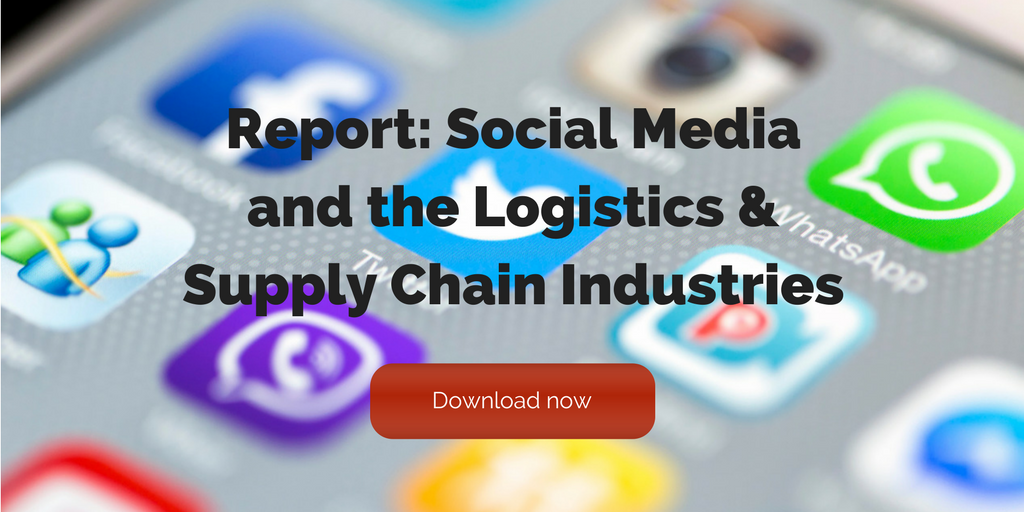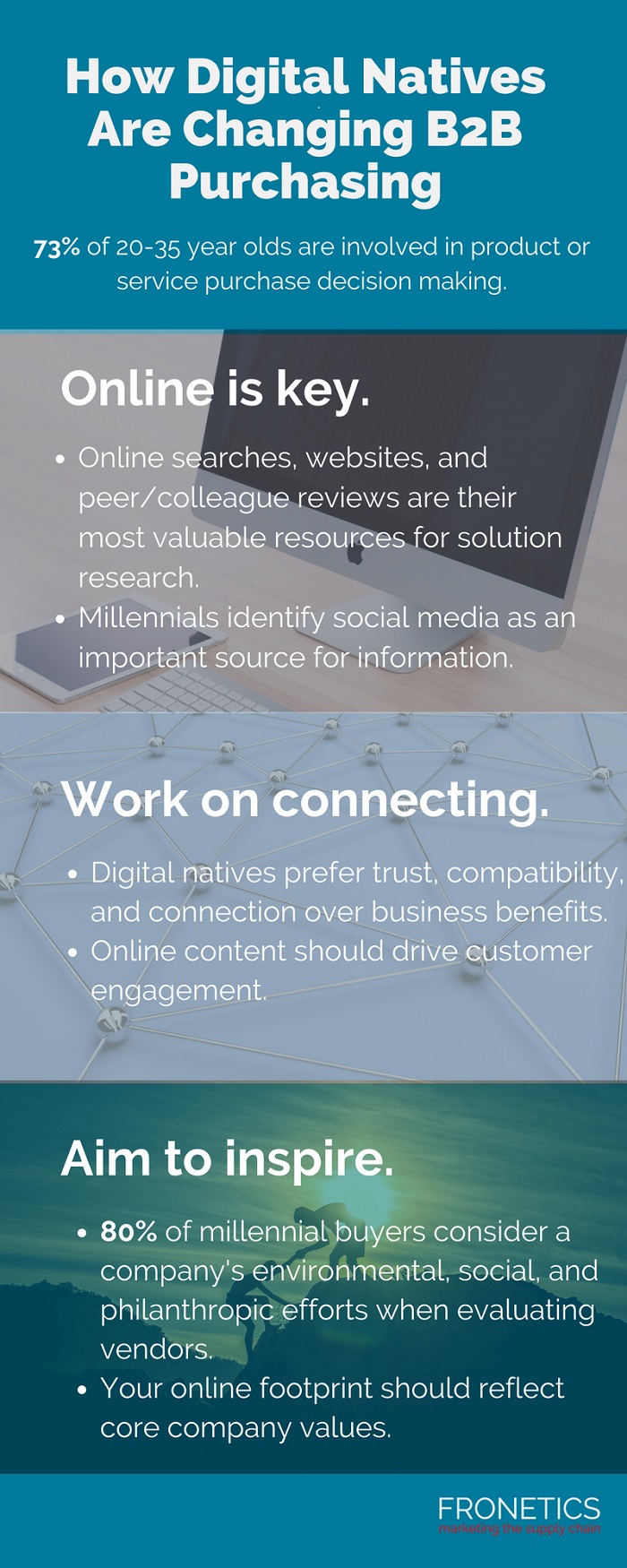
by Elizabeth Hines | Sep 19, 2018 | Blog, Content Marketing, Data/Analytics, Logistics, Marketing, Supply Chain
Automation has two major benefits for supply chain marketers: it drives efficiencies and improves success rates in earning and converting leads.
When you think about automation in the supply chain, you probably don’t immediately consider marketing and sales. Perhaps you envision robots scooting around warehouse floors, or maybe you think of applications in billing, compliance reports, or order auditing. However, advances in automation have impressive implications for marketing and sales in the supply chain as well.
Automation has two major benefits for supply chain marketers. Like all automation, it drives efficiencies, allowing your team to devote more time to other core competencies. What you may not know, however, is that it also improves success rates in earning and converting leads. In fact, HubSpot reports that businesses using marketing automation to nurture leads receive a whopping 451% increase in qualified leads.
New trends in marketing automation – particularly those which function more like artificial intelligence – can streamline and improve your marketing and sales efforts. Here’s how.
Integrate marketing automation into your CRM strategy
Integrating marketing automation into your customer relationship management (CRM) strategy may not be the first thing that came to mind, but the two work beautifully in tandem.
An integrated approach will take all three of the following areas to the next level:
- Track behavior. Automation lets you go far beyond basic demographic data, seeing things like what pages your prospects are visiting, what types of content they’re interested in, and where they are in the buying cycle.
- Send targeted messages. You can use the behavioral information collected by your marketing automation tool to create and send targeted messages that are customized to your prospects’ interests and stage in the buying cycle. This means your prospects will find your messages more relevant and engaging.
- Establish clear ROI. Establishing a clear link between marketing efforts and sales is a constant thorn in the side of most marketers, but new advances in automation make measuring ROI a little clearer. Creating a campaign in your marketing automation system maps it back to your CRM, so you can correlate closed deals directly with the campaigns that created them.
Basically, combining CRM with marketing automation can give you more organizational bandwidth, more precision in your messaging and lead nurturing, and more measurable value in your campaigns.
Create targeted messages with email workflows
There’s no area in which marketing automation is more helpful than in the creation of automated but extremely pertinent email workflows to your sales leads.
Based on the information you have about your leads and/or their engagement with your website, email workflows trigger a series of pre-determined highly-relevant emails at designated intervals, inviting them to take action and helping them to move down the sales funnel.
Email workflows do require considerable work upfront as you consider individual buyer profiles, their place within the buyer’s journey, and what timely and relevant information will advance them. But thoughtful well-designed email workflows can translate to substantial time savings and increases in lead conversion later.
More marketing automation: Social media scheduling tools & chatbots
Two other areas in which automation is making a big splash in marketing and sales are social media scheduling tools and chatbots.
The targeted approach of email workflows increases their chances of being read, but I don’t need to point out that – no matter how perfect your email might be – people are still buried in emails. On average, office employees receive 121 emails per day. Only around 20% are opened, and click-through rates are even lower.
[bctt tweet=”On average, office employees receive 121 emails per day. Only around 20% are opened, and click-through rates are even lower.” username=”Fronetics”]
So, in addition to email workflows, the newest trends in automation are social media scheduling tools and chatbots. Both of them can make your job much easier — and improve your bottom line.
Social media scheduling tools
Social media scheduling tools, like those offered by HubSpot and Hootsuite, let you plan and schedule content across your social networks.
For example, HubSpot’s comprehensive CRM and marketing platform includes the ability to automatically post to social media when you publish content, as well as in-depth analytical tools for determining the best time to post to social media platforms. You can also monitor social mentions and link your social media activity with larger marketing campaigns to determine ROI.
Hootsuite lets you keep track of various social media channels at once. It also helps you perform brand monitoring, letting you know when you brand is mentioned, and what your customers are saying.
As you can imagine, using a social media monitoring tool can greatly improve efficiency, cutting into the sometimes-seemingly-endless manual hours spent on social media monitoring and posting.
Chatbots
A chatbot is s a computer program that simulates human conversation using auditory or textual methods. It communicates with your customer inside a messaging app, like Facebook Messenger, and is similar to email marketing without landing in an inbox.
Chatbots are the latest trend in marketing, and their increasing popularity is making it harder to ignore how artificial intelligence is helping shape the content marketing landscape. It’s certainly timely. Business Insider recently reported that the number of people on messaging apps surpassed the number of users on social networks!
Messaging automation is the new email automation, and it can work for supply chain and logistics industries too. Chatbots currently allow for increased customer engagement through messaging app technology that isn’t yet saturated with marketing, and your brand will also appreciate the ease of tracking and segmenting your customers through chatbots.
Marketing automation is for the supply chain
Automation isn’t just for the warehouse or the finance and billing department. It’s also for this crazy constantly-changing world of marketing in supply chain and logistics industries. Marketing automation can make a big difference in your marketing and sales efforts.
Integrating automation with your CRM strategy, creating targeted email workflows, and the newest advances like social media scheduling tools and chatbots can all add up to major time savings and substantial increases in lead conversion rates.
This post originally appeared on EBN Online.
Related posts:


by Fronetics | Sep 18, 2018 | Blog, Content Marketing, Current Events, Logistics, Marketing, Social Media, Strategy, Supply Chain
Ask yourself these five questions before you dive headfirst into an influencer marketing campaign to set you on the right path.
We’ve been writing a lot lately about influencer marketing and how it can work for the supply chain. These campaigns can be extremely effective — but getting the most bang for your buck requires a strategic approach from the outset.
Before you start an influencer marketing campaign, ask yourself these 5 questions.
5 questions to ask before starting an influencer marketing campaign
1. Why do I want to use influencers?
According to Natasha Lekwa, influencer marketing and social media editor at Snapchat, it’s important to “make sure you have a clear idea why you want to use influencers.” Answers might include boosting brand awareness, gaining followers, or increasing sales, to name a few. But each of these answers will lead you to a different strategy.
Being fully and deliberately aware of why you’re embarking on a campaign will help you set key performance indicators, determine your audience, and “envision what success will look like at the end of the campaign.” You’ll also be able to choose strategically the best platform to use, based on your content and target demographic.
2. Who are my influencers?
It may seem obvious, but you’d be surprised how often businesses dive into an influencer marketing campaign without having fully identified key influencers in their sector.
Lekwa suggest using hashtags to search Instagram for appropriate influencers and advises not just focusing on the obvious influencers in your industry. In fact, exploring influencers in other related industries can help expand your reach.
3. Who are my micro-influencers?
[bctt tweet=”Micro-influencers can give you a much higher ROI than big stars, and audience engagement tends to get higher as social niches get narrower.” username=”Fronetics”]
So you’ve identified your major influencers. Now you can start thinking about your “micro-influencers,” those with 10K to 100K followers. “Micro-influencers can give you a much higher ROI than big stars, and audience engagement tends to get higher as social niches get narrower,” Lekwa says. And since engagement is the name of the game when it comes to any kind of social media marketing, micro-influencers can be enormously valuable.
4. What are your terms?
Since influencers tend to be content creators at heart, they often have plenty of great ideas. But it’s important that your goals are transparent and aligned.
“It’s important to be on the same page,” says Lekwa. “Having a clear contract that spells out what each side will execute will help manage expectations for both your team and for the influencer.” In fact, Lekwa points out that influencers generally appreciate having guidelines and “the big conceptual themes of a campaign handed to them.”
5. What is my own value?
Approaching influencers can be intimidating. As Forbes writer Andrey Slivka points out, “As you might expect from people who get deluged with free stuff, influencers can be hard to impress.” This means you need to be clear and specific when you approach them about what you have to offer.
“Especially with micro-influencers, who are building their brands, what you offer doesn’t always have to be monetary,” Lekwa says. Often, brands can offer influencers exposure, the prestige of having their own brand associated with a larger business, or the resources to improve their content production.
Influencer marketing can be daunting at first, but it’s a powerful tool of the supply chain. If you lay the right foundation, an influencer marketing campaign has the potential to expand your brand’s reach exponentially.
Related posts:


by Fronetics | Sep 17, 2018 | Blog, Content Marketing, Logistics, Marketing, Social Media, Strategy, Supply Chain
Today’s B2B buyers are mostly digital natives who get the majority of their purchasing information from online searches, vendor websites, and peer recommendations.
From a content marketing perspective, knowing where your buyers get their information is critical to an effective strategy. So what are most important sources of information for today’s B2B buyers? 20 years ago, you might have named things like product info sheets or sales reps. But not anymore.
B2B buying has completely evolved, thanks in large part to the increasing percentage of digital natives who now make up the B2B purchasing landscape.
Is your content marketing strategy meeting buyers where they are? Here are the three most important sources of information for B2B buyers.
3 top sources of information for B2B buyers
1. Online search
Not only is an online search the first move for 62% of B2B buyers, 94% of buyers report using online research at some point during the purchasing process. And this isn’t a surprise, when you consider that, according to a study of millennial buyers by Merit, “some 73% of 20 to 35 year olds are involved in product or service purchase decision-making at their companies.”
[bctt tweet=”Not only is an online search the first move for 62% of B2B buyers, 94% of buyers report using online research at some point during the purchasing process.” username=”Fronetics”]
So what does this mean for your business? Gone are the days when a simply thinking about keyword rankings was enough to boost your SEO. In our four-part series on writing for SEO, we address how search engines and the search landscape have changed over the past several years. Improving your search ranking can seem like a complex process, but in the end it all boils down to one thing: quality content, presented in a clear and compelling manner.
2. Vendor websites
So buyers conduct their online search. And if you’ve done your content marketing homework, they find your business. How does your website stack up?
According to Bain’s global customer insights chief Eric Almquist, by the time they reach your website, buyers “will have already formed a strong opinion about many aspects of the value expected from a vendor.” For this reason, your website should “provide a wealth of information on these types of value, with details on where… products have been successful.”
Your website should be one of your primary assets. If you don’t give visitors plenty of easy, attractive opportunities to convert on your website, content marketing won’t generate leads for you. Your content should be organized and clear, presented with the goal of helping your potential customers. And opportunities for conversion should be everywhere.
3. Peers and colleagues
As digital natives step into purchasing roles in the supply chain, they’ve “brought their consumer habits to the B2B world,” says Almquist. This means that a big part of the purchasing process involves review sites, where purchasers seek the opinion of their peers and colleagues. “Reviews will tell the buyer how a vendor performs on many ease-of-doing-business elements long before the buyer has actual experience with that vendor.”
This aspect of content marketing can seem daunting for many businesses because of the perception that what’s on these sites is completely out of your control. But with the right strategy in place, review sites are actually a big opportunity for your business.
For a start, vendors “should encourage customers who are advocates of the company to provide reviews on relevant sites.” It’s also important to take an active role on these sites, responding to customer reviews — even the occasionally inevitable bad ones.
Says Almquist, “First impressions matter as much as ever in B2B markets. Today though, that first look comes through websites, user forums, and quick case studies, not flesh-and-blood sales pitches.”
With a well-thought-out, data driven content marketing strategy, you’ll be ready to meet digital natives where they are.
What sources of information for B2B buyers do you focus on?
Related posts:


by Fronetics | Sep 10, 2018 | Blog, Content Marketing, Leadership, Logistics, Marketing, Supply Chain
In today’s rapidly evolving economy, embracing change is crucial for success. These 5 behaviors define supply chain leaders who are change-agile.
They say the only constant in life is change. When it comes to leadership in the supply chain, the old adage certainly rings true.
If the last few decades have been consistent in any regard, it has been in the need to embrace change to keep things running. Agile leadership has been crucial for supply chain and logistics businesses. Are you the kind of leader that truly embraces change?
Why do I need to embrace change?
NextBridge Consulting managing partner Edith Onderick-Harvey identifies 5 behaviors that are common among agile leaders. Onderick-Harvey points to an inability to embrace change as a key cause of failure in business — making the idea of “change-agile” leadership a crucial part of a business and a leader’s DNA.
[bctt tweet=”Being a successful leader depends on embracing change by “seizing opportunities, including throwing out old models and developing new ways of doing business,” writes Onderick-Harvey.” username=”Fronetics”]
Change isn’t easy in any area of life, and corporate leadership is no exception. However, being a successful leader depends on embracing change by “seizing opportunities, including throwing out old models and developing new ways of doing business,” writes Onderick-Harvey. She stresses the importance of inculcating a culture of “change thinking… from the most fundamental daily interactions to the most complex strategy.”
What defines a change-agile leader?
Onderick-Harvey identifies these five behaviors that are characteristic of change-agile leaders:
1. They share a compelling, clear purpose.
Embracing change just for the sake of isn’t enough. “If you can’t articulate a clear purpose behind the changes being made,” says Onderick-Harvey, “it’s unlikely that your employees will be able to implement them.”
2. They look ahead and see opportunity.
It’s not just senior executives who should be looking toward future opportunities. A culture of change-agility should pervade every level of the corporate structure. “Look beyond this month or this year to identify trends and take action.”
3. They seek out what’s not working.
Being a change-agile leader goes beyond simply being receptive to unsuccessful projects — it’s about encouraging communication and actively seeking out what isn’t working at any level of your business. “For real learning to occur,” writes Onderick-Harvey, “people need to feel psychologically safe to share the good, the bad, and the ugly.”
4. They promote calculated risk-taking and experimentation.
We all know that risk and experimentation are crucial for growth, but many of us are too reticent to boldly embrace these concepts. It’s not easy to remember that failure is an important step on the way to success. “Change agility requires leaders to ask ‘Why not?’ and to establish opportunities for pilots, prototypes, and experimentation.”
5. They look for boundary-spanning partnerships.
As the world grows ever more interconnected and work becomes more complex, success is increasingly dependent on seeking out collaboration across boundaries. “Change-agile leaders and organizations are replacing functional silos with formal and informal organizations that allow for the rapid flow of information and decision-making around a product, customer, or region.”
Welcoming and embracing change is good for every aspect of your business’ health. Do these behaviors sound like you? What can you do to promote change-agility in your business’ culture?
Related posts:


by Fronetics | Sep 6, 2018 | Blog, Content Marketing, Current Events, Logistics, Marketing, Social Media, Strategy, Supply Chain
Digital natives are changing the landscape for B2B purchasing. Here’s what you need to know about the new B2B buyer.
Long gone are the days of men and women sitting around a conference table listening to a sales pitch over a free lunch. Today’s B2B buyers are younger, more technologically savvy, and more independent — they’re a generation of digital natives. And they’re making waves across the B2B buying landscape and changing how marketers must work to reach new customers.
[bctt tweet=”Today’s B2B buyers are younger, more technologically savvy, and more independent — they’re a generation of digital natives. And they’re making waves across the B2B buying landscape and changing how marketers must work to reach new customers.” username=”Fronetics”]
Who are digital natives?
The term digital native describes a person that grows up in the digital age, rather than acquiring familiarity with digital systems as an adult. So, unlike the previous generation, digital natives grew up understanding how to work a computer and a mobile phone instead of picking up these skills (slowly) in our 20s, 30s, or even later.
Having grown up in a time of rapid technological advancement, digital natives are very comfortable online. These skills have carried over to their professional careers, as millennials descend upon the workforce. Organic searches have become the starting point for researching products and services, instead of looking for specific brands.
Ch-ch-changes
This new reality means marketers trying to reach new customers must make big changes in the way they target and engage today’s buyers. Marketers have had to shift their focus from outbound marketing to inbound tactics, like content marketing, to engage and connect with their target audiences.
Here’s what you need to know about digital natives and how their tech-savvy ways have changed the B2B purchasing process.
Infographic: How digital natives are changing B2B purchasing

(Made with Canva)
Final thoughts
With so much content available on the internet, first impressions are everything. Your website needs to be informative and visually pleasing. Your social media posts need to be engaging. Your blog posts need to be enlightening. Make sure your online presence accurately depicts who you are as a brand and what you stand for. Digital natives will be more likely to find and connect with you.
Have digital natives had an impact on your business? Tell us about it.
Related posts:












